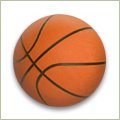Monday, June 16, 2008
Back in the Game
A recent article in the journal Practical Pain Management reported that 15% of basketball players have lost time from play due to low back pain.
While this is nowhere near the rates for ankle, finger, and knee injuries, it's still worth taking a closer look.
Basketball is a game of quick actions and reactions, and when your back "is out of whack" so is your game - it can adversely affect your shot, your defense, your ability to box out, you name it.
Here are some of the most common back injuries in basketball:
muscle sprain/strain - a pulled muscle or ligament (attaches bone to bone) in your back.
delayed-onset muscle pain - muscle soreness from overuse that is usually worst about 2 days after exercise.
contusions - bruises from getting elbowed or hitting something hard (the floor, another player)
disc herniations - more common in older (30+) players, these injuries can cause shooting electrical shock-like pain in the back and down the leg while also causing weakness and/or numbness in the legs.
piriformis syndrome - occurs when a tight muscle in your buttocks irritates a nerve that causes pain to shoot down your leg (similar to pain from a disc herniation).
sacroiliac joint pain- soreness in the low back where the tailbone and hip bones join together.
stress fractures - tiny breaks in the backbones caused by muscle weakness and overuse .
spondylolysis/spondylolisthesis - fractures of the backbones that lead to slippage of one backbone over the other .
So what can you do?
The best step is to do what you can to prevent a low back injury from ever happening. Work on maintaining and increasing your aerobic conditionining, flexibility and strength (not just in your back but in your hips, legs, shoulders, and abdomen). Make sure you wear proper shoes and play on safe surfaces.
If you sustain an injury, see a local health care provider who can perform a history and physical exam and additional tests (x-rays, ultrasound, bone scans, CT or MRI scans or other tests) to help make the correct diagnosis.
Treatment and rehabilitation will depend on the diagnosis, but generally, relative rest is an important part of any recovery program. Therapy from an athletic trainer or physical therapist may include ice packs early on and heating pads later in the process. Over the counter medicines like ibuprofen (or steroid injections in more severe cases) can help reduce some of the inflammation and pain, allowing you to tolerate soft tissue mobilization (therapeutic massage), stretching, and strengthening programs.
You can maintain your cardiovascular fitness by doing aquatic therapy (aqua jogging, for example) elliptical trainers, and/or recumbent bicycling.
Above all, make sure that you are fully recovered, in good cardiovascular shape, and strong and flexible as this will help you perform at your best and avoid further injury when you get back in the game.
Subscribe to:
Post Comments (Atom)









1 comment:
Genial fill someone in on and this enter helped me alot in my college assignement. Gratefulness you as your information.
Post a Comment